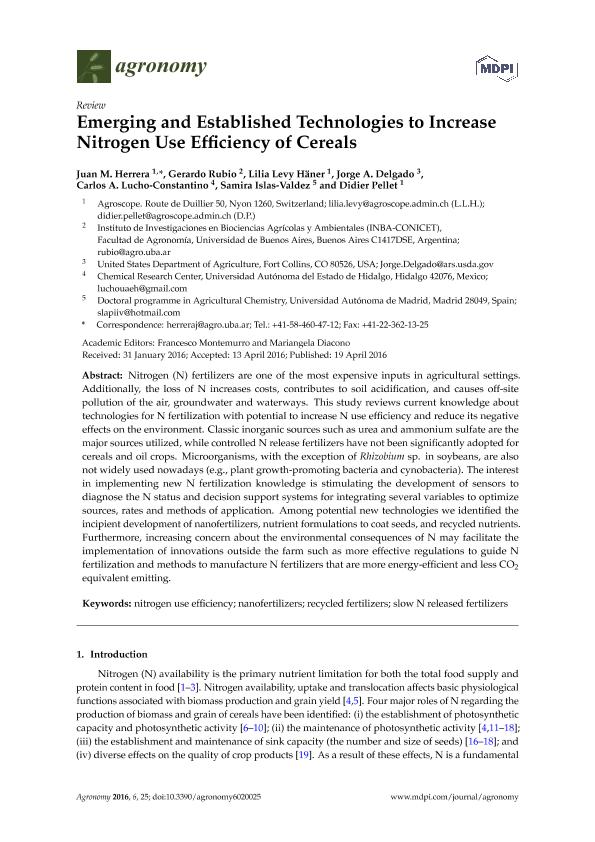Artículo
Emerging and established technologies to increase nitrogen use efficiency of cereals
Herrera, Juan M.; Rubio, Gerardo ; Häner, Lilia Levy; Delgado, Jorge A.; Lucho Constantino, Carlos A.; Islas Valdez, Samira; Pellet, Didier
; Häner, Lilia Levy; Delgado, Jorge A.; Lucho Constantino, Carlos A.; Islas Valdez, Samira; Pellet, Didier
 ; Häner, Lilia Levy; Delgado, Jorge A.; Lucho Constantino, Carlos A.; Islas Valdez, Samira; Pellet, Didier
; Häner, Lilia Levy; Delgado, Jorge A.; Lucho Constantino, Carlos A.; Islas Valdez, Samira; Pellet, Didier
Fecha de publicación:
06/2016
Editorial:
MDPI
Revista:
Agronomy
ISSN:
2073-4395
Idioma:
Inglés
Tipo de recurso:
Artículo publicado
Clasificación temática:
Resumen
Nitrogen (N) fertilizers are one of the most expensive inputs in agricultural settings. Additionally, the loss of N increases costs, contributes to soil acidification, and causes off-site pollution of the air, groundwater and waterways. This study reviews current knowledge about technologies for N fertilization with potential to increase N use efficiency and reduce its negative effects on the environment. Classic inorganic sources such as urea and ammonium sulfate are the major sources utilized, while controlled N release fertilizers have not been significantly adopted for cereals and oil crops. Microorganisms, with the exception of Rhizobium sp. in soybeans, are also not widely used nowadays (e.g., plant growth-promoting bacteria and cynobacteria). The interest in implementing new N fertilization knowledge is stimulating the development of sensors to diagnose the N status and decision support systems for integrating several variables to optimize sources, rates and methods of application. Among potential new technologies we identified the incipient development of nanofertilizers, nutrient formulations to coat seeds, and recycled nutrients. Furthermore, increasing concern about the environmental consequences of N may facilitate the implementation of innovations outside the farm such as more effective regulations to guide N fertilization and methods to manufacture N fertilizers that are more energy-efficient and less CO2 equivalent emitting.
Archivos asociados
Licencia
Identificadores
Colecciones
Articulos(INBA)
Articulos de INST.DE INVEST. EN BIOCIENCIAS AGRICOLAS Y AMBIENTALES
Articulos de INST.DE INVEST. EN BIOCIENCIAS AGRICOLAS Y AMBIENTALES
Citación
Herrera, Juan M.; Rubio, Gerardo; Häner, Lilia Levy; Delgado, Jorge A.; Lucho Constantino, Carlos A.; et al.; Emerging and established technologies to increase nitrogen use efficiency of cereals; MDPI; Agronomy; 6; 2; 6-2016; 1-25
Compartir
Altmétricas



